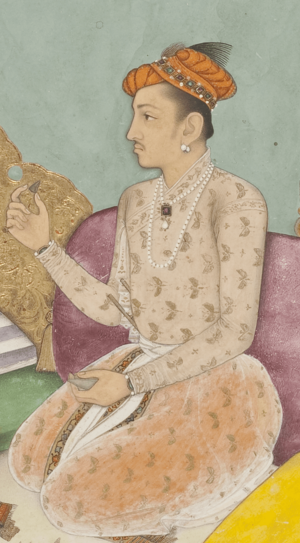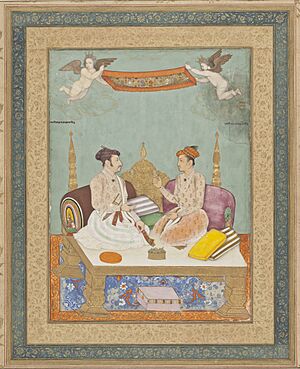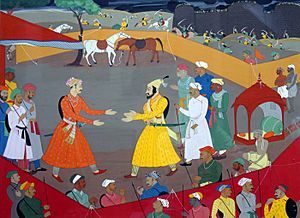Jai Singh I facts for kids
Quick facts for kids Amir-ul-Umara Mirza Raja Jai Singh I |
|
|---|---|
| 27th Raja of Amber | |

Portrait of Raja Jai Singh I from a Mughal folio
|
|
| Raja of Amber | |
| Reign | 13 December 1621 – 28 August 1667 |
| Predecessor | Bhau Singh |
| Successor | Ram Singh I |
| Born | 15 July 1611 Amber, Kingdom of Amber (present-day Rajasthan, India) |
| Died | 28 August 1667 (aged 56) Burhanpur, Khandesh subah, Mughal Empire (present-day Madhya Pradesh, India) |
| Spouse | Rathorji Mrig Kanwarji d.of Sur Singh of Marwar
Jadonji Anand Kanwarji d.of Raja Mukundpal Dev Ji of Karauli Chandrawatji Roop Kanwarji of Rampura State Bikawatji Har Kanwarji d.of Kunwar Kishan Singhji and grand-daughter of Raja Rai Singh of Bikaner Chauhanji Raj Kanwarji |
| Issue | Ram Singh I
Kirat Singh Hari Singh Vijay Singh Bal Singh |
| Father | Yuvraj Maha Singh |
| Mother | Sisodiniji Damyanti Deiji d.of Kunwar Shakti Singh and grand-daughter of Maharana Udai Singh II of Mewar |
| Religion | Hinduism |
Mirza Raja Jai Singh I (born July 15, 1611 – died August 28, 1667) was a very important general and ruler in India. He was a powerful leader of the Kachwaha kingdom of Amber, which is now known as Jaipur. He also held a high position in the court of the Mughal Empire. Jai Singh I took over from his grand uncle, Mirza Raja Bhau Singh.
Contents
Becoming a Ruler and Early Battles

Jai Singh I became the Raja (ruler) of Amber when he was only 10 years old. He also became the leader of the Kachwaha Rajputs. His military career lasted through the reigns of two Mughal emperors. These were Shah Jahan and the first ten years of Aurangzeb's rule.
Jai Singh's military journey began in 1627. This was when Shah Jahan became the Mughal emperor. A commander named Khan Jahan Lodi rebelled. Jai Singh quickly brought his army to help defeat the rebels. For his good service, he was made a commander of 4,000 soldiers.
In 1636, Shah Jahan planned a big campaign against the southern kingdoms. Jai Singh played a major role in this. Later, his army also fought against the Gond kingdoms. Because of his success, Jai Singh was promoted. He became a commander of 5,000 soldiers. The Chatsu district was also added to his kingdom. He also made his kingdom bigger by defeating the Meo tribes. In 1641, he stopped a rebellion by Raja Jagat Singh.
Adventures in Central Asia
In 1638, the fort of Kandahar was given to Shah Jahan. It was handed over by its Persian commander, Ali Mardan Khan. Shah Jahan's son, Shah Shuja, went with Jai Singh to take control of the fort. To show strength to the Persian Shah, Shah Jahan gathered a huge army. It had 50,000 soldiers in Kabul. During this time, Jai Singh received a special title. Shah Jahan gave him the title of Mirza Raja. This title had only been given to his grandfather, Raja Man Singh I of Amber, by Emperor Akbar.
In 1647, Jai Singh joined Shah Jahan's invasions of Balkh and Badakhshan. These areas are in Central Asia. However, these invasions were not successful.
In 1649, the Persians took back Kandahar. This was a big loss for the Mughals. In the war that followed, the Mughals tried twice to get Kandahar back. Prince Aurangzeb led these attempts in 1649 and 1652. Jai Singh was an army commander in both attempts. But they failed because the Mughal army did not have enough cannons. Their gunners also were not very good.
A third big attempt was made in 1653. Shah Jahan's oldest son, Dara Shikoh, led this army. Jai Singh was sent with this army again. Dara Shikoh's campaign had many problems. He was not a good military leader. He also had arguments with officers who had fought before. He often made fun of Jai Singh for past failures. But his own campaign also failed. After this, the Mughals stopped trying to get Kandahar back.
Dara Shikoh continued to be unfriendly towards Jai Singh. This was even after they returned to Agra. Jai Singh did not get any rewards for skillfully helping the army retreat. Instead, Jaswant Singh was made a commander of 6,000. He also received the special title of Maharaja.
Choosing Sides in a Royal War
In 1657, Emperor Shah Jahan became very sick. His three younger sons started to plan to take the throne. Shah Shuja in Bengal and Murad in Gujarat declared themselves emperors. But Aurangzeb cleverly said he only wanted to help his father.
Facing these three dangers, Dara Shikoh remembered Jai Singh. The Rajput chief was made a commander of 6,000. He was sent east with Dara's son, Sulaiman Shikoh, and the general Diler Khan. They won against Shah Shuja at the Battle of Bahadurpur in February 1658. They chased him back to Bengal.
By that time, Aurangzeb had won two important battles. He won the Battle of Dharmat and the Battle of Samugarh. He also captured Agra. Jai Singh and his men were far away in the east. Their homes and families were in the west, at the mercy of Aurangzeb's troops. So, Jai Singh and Diler Khan told Sulaiman Shikoh to escape. They then surrendered to the new emperor. Jai Singh also advised Maharaja Jaswant Singh not to help Dara Shikoh. This helped Jaswant Singh get a good position with Aurangzeb.
Even with his victories, Aurangzeb did not feel completely secure on the Mughal throne. He still needed the support of important generals. So, he forgave Maharaja Jaswant Singh. He also promoted Jai Singh to a commander of 7,000. This was the highest rank any general could achieve.
Battles Against the Marathas

The wars between the Mughal Empire and the southern kingdoms became more difficult. This was because of the rise of the Maratha king, Shivaji. In 1659, Shivaji killed Afzal Khan, a famous general. In 1664, he attacked the rich port city of Surat. Raja Jai Singh was chosen to lead a large army of 14,000 soldiers. His mission was to fight against the southern kingdoms and the growing Marathas.
Jai Singh captured several forts in Maharashtra from Shivaji. He then surrounded the Purandar Fort. This forced Shivaji to sign the Treaty of Purandar in 1665. Jai Singh convinced Shivaji to make peace. He also suggested they join forces to invade Bijapur. This would benefit both the Marathas and the Mughals. Jai Singh was praised for this victory. He received many valuable gifts. His two sons, Ram Singh and Kirat Singh, were also promoted in rank.
Marching Towards Bijapur
The invasion of the Sultanate of Bijapur began in December 1665. Jai Singh now had an army of 40,000 soldiers. Shivaji added 7,000 foot soldiers and 2,000 horsemen. The Bijapur army avoided direct fights. Jai Singh's army reached within 12 miles of Bijapur city. However, the defenders burned their own lands. This meant Jai Singh's army ran out of food supplies. He had to start retreating in January 1666.
Later Years and Legacy
Aurangzeb blamed Jai Singh's son, Ram Singh I, for Shivaji's escape. He took away Ram Singh's lands and sent him away from the court. Ram Singh was later forgiven. He was sent to fight in the Battle of Saraighat in faraway Assam. After Jai Singh's failed invasion of Bijapur, Aurangzeb was not happy with him. He was replaced as the viceroy of Deccan. Jai Singh was called back to the royal court. On his way, Jai Singh died in Burhanpur on August 28, 1667.
His family faced difficulties for the next two generations. But their fortunes improved later with Jai Singh II. Aurangzeb built a Chhatri (a special memorial) for Jai Singh I. It is on the bank of the Tapti River in Burhanpur. It is now called "Raja Ki Chhatri."
See also
- List of Rajputs

